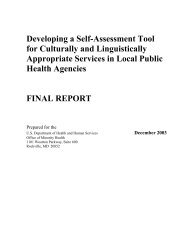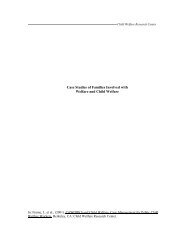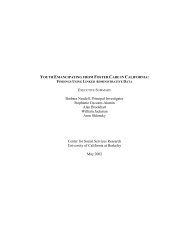Family Assessment in Child Welfare - Center for Social Services ...
Family Assessment in Child Welfare - Center for Social Services ...
Family Assessment in Child Welfare - Center for Social Services ...
Create successful ePaper yourself
Turn your PDF publications into a flip-book with our unique Google optimized e-Paper software.
of adm<strong>in</strong>istration, <strong>in</strong> terms of time, <strong>in</strong>structions, scor<strong>in</strong>g, and clarity of <strong>in</strong>terpretation; (6) otheradvantages and disadvantages related to use <strong>in</strong> the child welfare sett<strong>in</strong>g, such as the read<strong>in</strong>g levelrequired of clients or prior use by caseworkers; and (7) psychometric properties. Thepsychometric properties of the <strong>in</strong>struments were rated on a four po<strong>in</strong>t scale, from those hav<strong>in</strong>gthe least psychometric <strong>in</strong><strong>for</strong>mation available to those hav<strong>in</strong>g psychometric <strong>in</strong><strong>for</strong>mation available<strong>for</strong> all of the stages of assessment that the <strong>in</strong>strument addressed.A ten percent sample of the <strong>in</strong>strument evaluations was reviewed by an <strong>in</strong>dependentreviewer to establish the <strong>in</strong>ter-rater reliability of the evaluation process. Two discrepancies werefound with regard to the comprehensiveness of the family assessment doma<strong>in</strong>s that an <strong>in</strong>strumentaddressed and <strong>in</strong> one case, with regard to the stage of assessment that the <strong>in</strong>strument addressed.These differences were reconciled with the <strong>in</strong>troduction of additional sub-criteria <strong>for</strong> evaluation.Major F<strong>in</strong>d<strong>in</strong>gsOverviewEighty five (n=85) <strong>in</strong>struments perta<strong>in</strong><strong>in</strong>g to family assessment were evaluated (seeAppendix C). Of these, the majority typically addressed one to two doma<strong>in</strong>s of familyassessment, such as patterns of social <strong>in</strong>teraction and parent<strong>in</strong>g practices. The majority of the<strong>in</strong>struments relied on self-report methods and/or observational rat<strong>in</strong>g scales (80%). A smallernumber of <strong>in</strong>struments <strong>in</strong>cluded structured <strong>in</strong>terviews (15%) and methods rely<strong>in</strong>g on structuredtasks such as games (4%).Figure 2. Instruments/Models Address<strong>in</strong>g <strong>Family</strong> <strong>Assessment</strong> Doma<strong>in</strong>s (n=85) 2<strong>Family</strong> <strong>Assessment</strong> Doma<strong>in</strong>sPatterns of <strong>Social</strong> Interaction (the nature of contact and <strong>in</strong>volvement withothers, the presence or absence of social support networks andrelationships)Parent<strong>in</strong>g Practices (methods of discipl<strong>in</strong>e, patterns of supervision,understand<strong>in</strong>g of child development and/or of emotional needs ofchildren)Background and History of Caregivers (<strong>in</strong>clud<strong>in</strong>g the history of abuseand neglect)Problems <strong>in</strong> Access to Basic Necessities (such as <strong>in</strong>come, employment,adequate hous<strong>in</strong>g, child care, transportation and needed services andsupports)Other Behaviors and Conditions (domestic violence, mental illness,physical health, physical, <strong>in</strong>tellectual, and cognitive disabilities, alcoholand drug use)Number of InstrumentsAddress<strong>in</strong>g Doma<strong>in</strong>58432023188
















